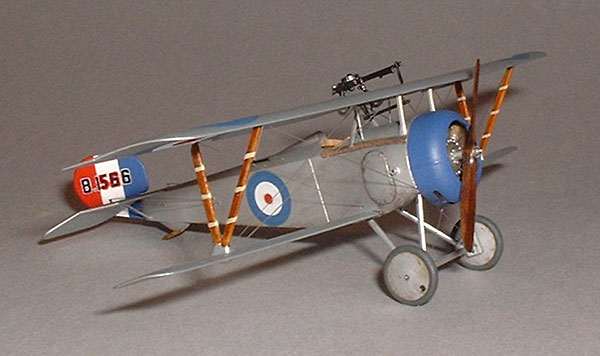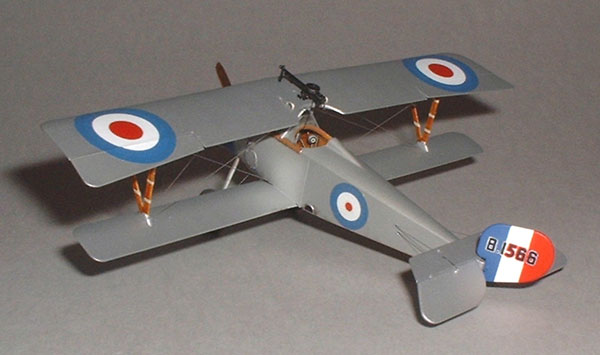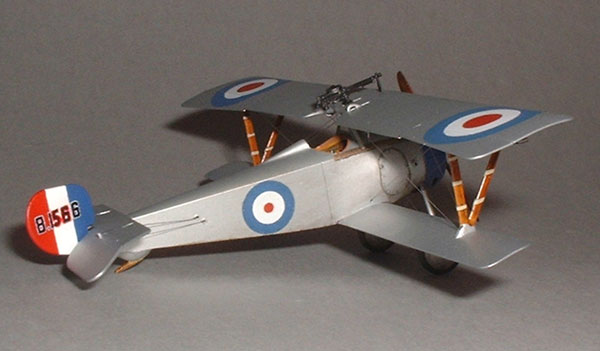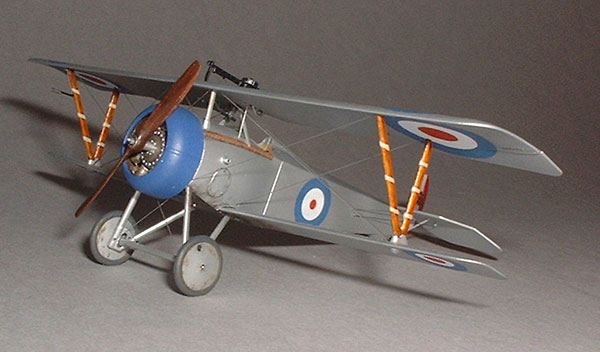| Eduard 1/72nd Nieuport 17 |
| |
 |
|
| I was disappointed when I picked up Osprey's "Nieuport
Aces of World War 1" by Norman Franks whilst building this to find
that there wasn't a single photograph or colour profile of Billy Bishop's
aircraft in there. In fact, the only mention of Bishop at all was one tiny
paragraph in the 60 Squadron write-up! Hardly seems appropriate for the
RFC's second highest scoring ace, especially when Albert Ball gets almost
a page and a half. Mainly thanks to the dubious docudrama "The Kid
who Couldn't Miss", Billy Bishop's reputation seems to have suffered
irreparable damage in the last few decades and the controversy surrounding
his award of the VC for a solo raid that can't be substantiated by eyewitnesses
or German records rages on. Perhaps Mr. Franks shares this bias or maybe
he just doesn't want to get involved in the controversy, but Bishop deserves
far better than this. Personally I think every WW1 pilot should have got
a medal just for climbing in these frail underpowered contraptions, let
alone flying them through snowstorms and getting shot at. |
| |
 |
|
| Never one to shy away from controversy, I present my own little
tribute to Canada's top scoring WW1 ace. Eduard's Nieuport 17 is one of
the easiest biplane kits I've ever built. The moulding is superb, fit is
excellent and the top wing - usually the biggest source of frustration -
lines up exactly as it should do. There are a few things that require tweaking
and a bit of extra detail here and there never goes amiss but then, what
kit is perfect? And would the "perfect kit" be as enjoyable to
build? We'll probably never know.... ¦¬) |
| |
 |
|
I added a bit of extra detail in the cockpit and substituted
a p/e seat back which is a much better representation of the typical Nieuport
seat than the kit item. Propeller is the usual carved wooden effort, rigging
stretched sprue, Aldis site is from stainless steel tubing and windscreen
from acetate.
My biggest complaint - perhaps my only complaint! - with the kit
is the engine which is really quite lame (see construction page for details).
Eduard didn't even attempt to protray the cooling fins other than four very
faint grooves on each cylinder so I tried wrapping them with fine wire to
liven them up a bit. After numerous episodes of broken and unravelled wire
I gave up on this idea in frustration and substituted the spare Le Rhone
from a Roden Camel which is far superior. I did cut off the induction pipes
from the Roden engine as I felt they were a bit two-dimensional and used
the seperate piece from the Eduard kit. |
| |
 |
|
| Paint is Poly S "Metalline" Aluminum with a mix
of Xtracolour Roundel Blue & USN True Blue for the cowling & rudder
stripe. Roundels are from Americal Gryphon with the tail codes pieced together
from their No. 1 Squadron sheet. For some reason AG printed the red outlines
exactly the same size as the black numbers which kind of defeats the purpose
so I hand painted the outlines with a #00000 brush - not fun! Bishop's aircraft
is nearly always depicted in paintings with large black '5s' & 'Cs'
on the wings & fuselage and blue wheel covers but I have yet to see
a photograph of it painted this way. I finished mine as it appears in the
only photo I've ever seen of B.1566. |
| |
 |
|
| Note that the fuselage exit holes for the elevator control
wires are moulded asymmetrical; one side has the upper hole forward with
the other side the reverse of this. I originally thought this was a mistake
but checking photos I discovered that this is actually correct for some
aircraft. Unfortunately not this one! Naturally I didn't discover it until
it was far too late to correct it without major destruction and repainting.
Actually credit must go to Matt Bittner for pointing this out - I probably
would have never noticed it! Great... thanks a lot Matt... ¦¬| |
| |
 |
|
| |
 |
|
| |
 |
|
| |
|
| |







